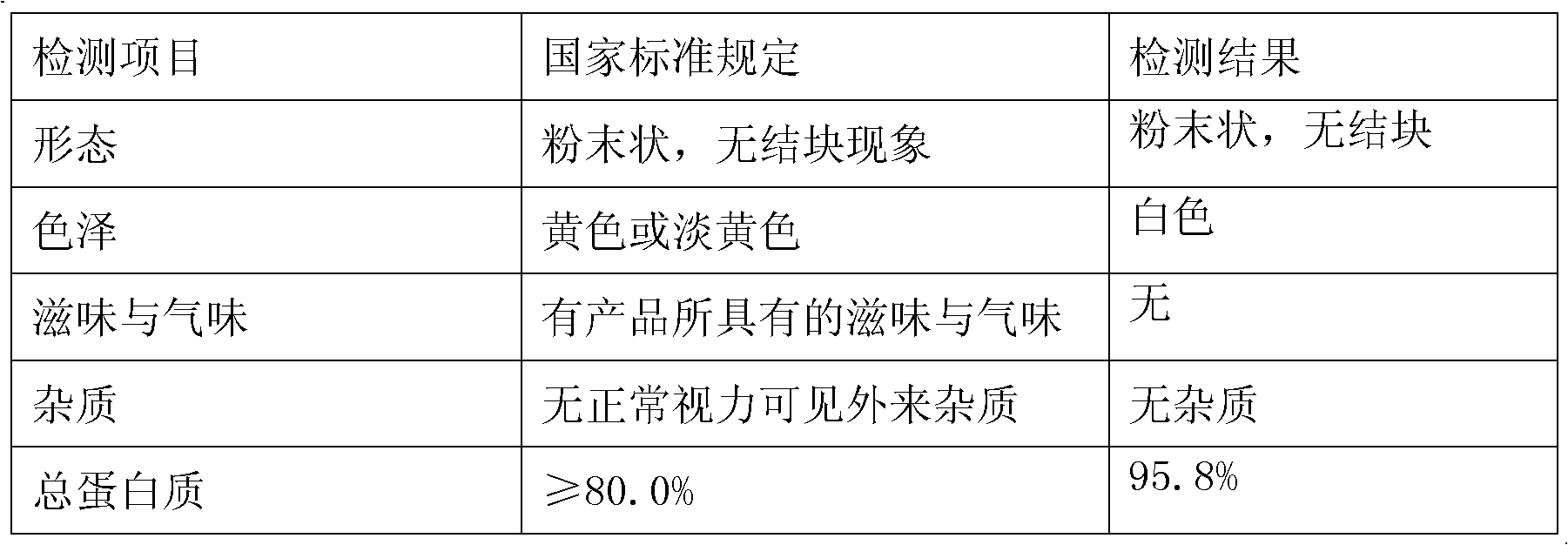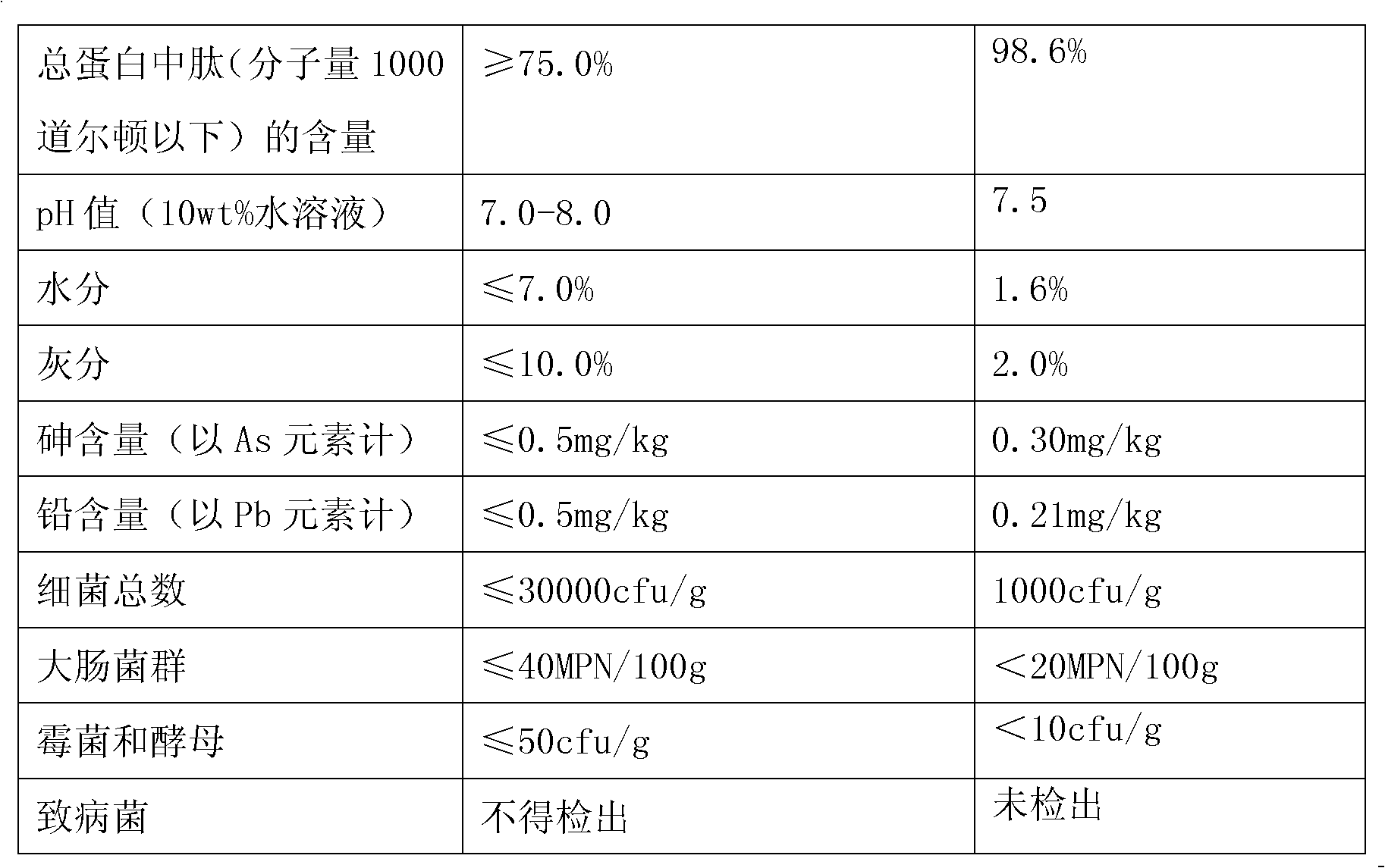Method for producing pea peptide through enzyme method
A pea peptide and enzymatic technology, applied in the field of deep processing of pea protein powder, can solve the problems of no membrane separation technology, destroy protein components, and destroy products, and achieve the effects of no toxic side effects, easy absorption, and short production cycle.
- Summary
- Abstract
- Description
- Claims
- Application Information
AI Technical Summary
Problems solved by technology
Method used
Image
Examples
Embodiment 1
[0022] A method for enzymatically producing pea peptides, the steps are as follows:
[0023] Weigh 1kg of commercially available pea protein powder (where crude protein>61wt%, moisture<10wt%, ash<3wt%) after passing through a 40-mesh sieve, add 7kg of distilled water, 50g of 95wt% ethanol and 10g of anhydrous sodium sulfite, and stir After uniformity, heat up to 90°C and reflux for 5 hours, and filter while hot after the reaction; then cool the filtrate to 50°C, adjust the pH to 7-8 with 0.1M food-grade flaky sodium hydroxide solution, then add 20g of alkaline protease, Stir and enzymolyze at 50°C for 6 hours. During the enzymolysis process, use the above-mentioned 0.1M sodium hydroxide solution to keep the pH value of the reaction system at 7-8; The sodium hydroxide solution of M keeps the pH value of the reaction system at 7-8; then the temperature is raised to 90° C., and the enzyme is kept for 20 minutes to kill the enzyme; then the enzymolysis solution is filtered to obta...
Embodiment 2
[0027] A method for enzymatically producing pea peptides, the steps are as follows:
[0028] Weigh 2kg of commercially available pea protein powder (where crude protein>61wt%, water content<10wt%, ash content<3wt%) after passing through a 40-mesh sieve, add 10kg distilled water, 200g 95wt% ethanol and 30g anhydrous sodium sulfite, stir After uniformity, heat up to 92°C and reflux for 4 hours, and filter while hot after the reaction; then cool the filtrate to 55°C, adjust the pH to 7-8 with 0.1M food-grade sodium hydroxide solution, and then add 60g of alkaline protease, Stir and enzymolyze at 55°C for 5 hours. During the enzymolysis process, use the above-mentioned 0.1M sodium hydroxide solution to keep the pH value of the reaction system at 7-8; Sodium hydroxide solution to keep the pH value of the reaction system at 7-8; then raise the temperature to 94°C and keep it warm for 16 minutes to inactivate the enzyme; then filter the enzymolysis solution to obtain a supernatant; a...
Embodiment 3
[0033] A method for enzymatically producing pea peptides, the steps are as follows:
[0034] Weigh 10kg of commercially available pea protein powder (wherein crude protein>61wt%, water content<10wt%, ash content<3wt%) after passing through 40 mesh sieve, add 60kg distilled water, 700g 95wt% ethanol and 200g anhydrous sodium sulfite, After stirring evenly, raise the temperature to 93°C and reflux for 4 hours, filter while hot after the reaction; then cool the filtrate to 55°C, adjust the pH to 7-8 with 0.1M food-grade sodium hydroxide solution, and then add 400g of alkaline protease , stirred at 55°C for 5 hours, during the process of enzymolysis, use the above 0.1M sodium hydroxide solution to keep the pH of the reaction system at 7-8; then add 200g of flavor protease, and perform enzymolysis at 55°C for 6 hours, during the process of enzymolysis, use the above 0.1 The sodium hydroxide solution of M keeps the pH value of the reaction system at 7-8; then heats up to 96°C and in...
PUM
 Login to View More
Login to View More Abstract
Description
Claims
Application Information
 Login to View More
Login to View More - R&D
- Intellectual Property
- Life Sciences
- Materials
- Tech Scout
- Unparalleled Data Quality
- Higher Quality Content
- 60% Fewer Hallucinations
Browse by: Latest US Patents, China's latest patents, Technical Efficacy Thesaurus, Application Domain, Technology Topic, Popular Technical Reports.
© 2025 PatSnap. All rights reserved.Legal|Privacy policy|Modern Slavery Act Transparency Statement|Sitemap|About US| Contact US: help@patsnap.com



